What’s the best SEO content strategy you should use to improve your search engine rankings and get more traffic?
Let’s do a quick quiz. Which of the following do you think would be the best SEO content strategy to rank higher in the search engines?
- Create new content
- Improve your worst performing content
- Improve your best performing content
The correct answer? The SEO content strategy that is most likely to create the best results in terms of bringing in additional traffic from search engines, social media and other sources?
It’s number three, improving your best content!
I realize this feels counter intuitive. Most of us, when we look at our site’s analytics, find that a small fraction of our pages are generating 80-95% of all our traffic.
Naturally, we tend to say, “those five pages are doing well, let’s focus our content strategy on doing more of what’s working, either by creating new content or fixing underperforming pages.”
But that’s not how the algorithm-driven online world works. The search engine algorithms and social media algorithms that choose which pages show up in the search results or social media feeds are merit-based. In other words, they tend to show those pieces of content that do well to more people.
Conversely, that content that doesn’t do well gets shown to fewer and fewer people as time goes on, until the algorithm sends nobody their way.
Here’s a video that outlines the process, then read further for a more-detailed description of a recommended SEO Content Strategy for you to pursue:
The Ideal SEO Content Strategy
Focus on those top-performing pages that are already getting the bulk of your traffic to go deeper into that topic and expand the search terms it ranks for to other related terms.
Here’s what’s probably happening: your page, as it’s currently written, may be one of the very best in the world for a certain term or terms that may not have very much competition.
For example, perhaps it’s appearing on the first page of the results for the term “decrease anxiety meditation” which gets an average of 10 searches per month.
But when you improve that content using some of the SEO content strategy techniques I’ll show you below, one or two things happen: either your page is seen as a better solution to peoples’ problems than it was before so now it appears higher in the search rankings for the terms you current rank for, bringing you more traffic.
And/or those improvements do a better job of covering more aspects of the subject. So now, in addition to ranking for “decrease anxiety meditation,” it starts ranking for “meditation to reduce anxiety” and “meditation to relieve anxiety”, which average 320 searches per month each.
And when this happens, because that page is doing so well in serving the needs of people who see it, that page will also start to show up for a bunch of other terms, each getting 10-300 searches per month. Cumulatively, your page will now be receiving a bunch more (a bunch – that’s a technical term 😊 ) traffic.
Since that worked, you decide to improve it again. Then, after a few more rounds of improvements, it continues to be ranked well on many of the pages it used to rank for, but now it perhaps starts appearing in results for “anti anxiety meditation” (480 searches per month,) “how to meditate for anxiety” (1000 searches per month,) and eventually, the keyword whale in this category: “meditation for anxiety” (14,800 searches per month.)
That’s the way the system works – the algorithms tend to identify certain pieces of content as best in class for certain searches. Then when those already top-performing pages are improved, they oftentimes start showing it in the results for other relevant terms. This continues as long as that page continues to perform well (and there’s not something a competitive page that’s performing better.)
That’s the why, now let’s talk about the how.
You’ve already got a good piece of content, let’s now talk about
How To Improve Your Content
One of the realities of the Internet is that content is never truly finished. No matter how good it is, it can always be improved to better serves peoples’ needs.
Sometimes to better serve the needs of those who are already finding it, sometimes to expand your reach to better serve other people who wouldn’t have found you otherwise.
Whenever I’m trying to improve content, I follow a specific 7-step system as part of my SEO content strategy:
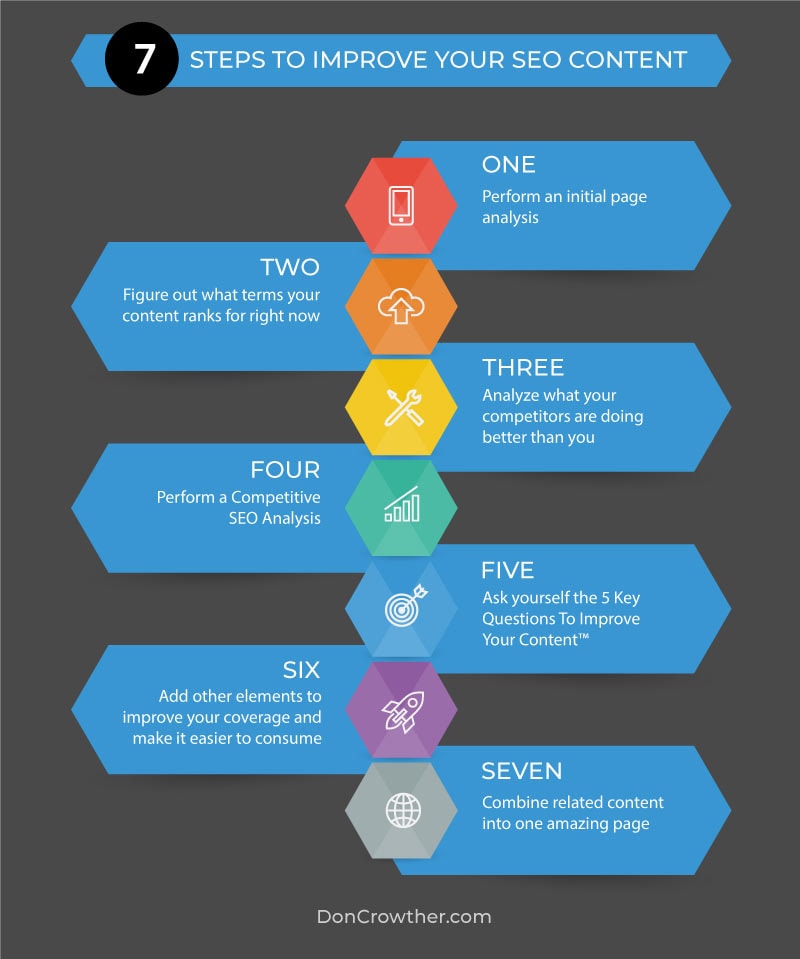
SEO Content Strategy Step 1: Perform An Initial Page Analysis
Choose one of your top performing content pages and call it up on your screen. Try to look at it through the eyes of a first-time viewer.
Ask yourself two questions:
- Why do I think this page is performing well right now?
- What could I do to make it perform better?
Look at everything as you think of this. (In fact, it helps to have more than one person doing this analysis, as different people will see things you’ll probably miss.)
- How good is its title?
- Does it start off strongly, with a clear indication of what it’s about and what problem it will help them solve?
- Is it well written: interesting, grammatically correct, informative, and entertaining?
- Is it easy to read, with short paragraphs and sentences?
- Is it written in a style and using levels of language and complexity that someone reading this type of content would find appropriate (chatty, academic, motivational, data-filled)?
- Does it use subheads?
- Does it look nice graphically?
- Does it include links out to other related information?
- Are long expanses of copy broken up with images, videos, pull-quotes, subheads, etc. to make them easier to consume?
- Does it contain multi-media? Videos, audios, infographics, charts, flowcharts, etc.
- Is it complete? What’s missing that someone interested in this topic would want to know?
- Is it up to date?
- Does it, when appropriate, outline a clear plan to help people resolve this issue in their lives?
- Etc.
Note: be sure you do this analysis looking at the page on both a wide-screen computer and a cellphone, so you can experience how viewers on both types of devices are receiving your content.
SEO Content Strategy Step 2: Figure Out What Terms Your Content Ranks For Right Now
You can try to figure this out on your own, guessing what terms it might be ranking for, and keying them into the search engines to see where it shows up, but frankly, that’s a waste of time.
I recommend you use one of the several tools specifically designed to do this like SpyFu, SemRush, AHrefs, or Ubersuggest.
Each of these tools gives you the ability to enter a page’s URL and see what keywords it ranks for, where in the rankings it falls, and where it ranks for that term.
Here’s an example report from SpyFu showing the results for the URL shown in the search bar at the top:

This information is valuable as it helps you see opportunities where, just by expanding your existing article to cover these other related areas in greater depth you may be able to grow your traffic with higher search engine rankings.
I can virtually guarantee that, if you’re getting any significant level of traffic to your top pages, you’ll be surprised at some of the search terms you’re currently ranking for.
And this analysis will probably show you opportunities you had never thought of.
SEO Content Strategy Step 3: Analyze What Your Competitors Are Doing Better Than You
Choose one of the top keywords you’re currently ranking for. Key that term into Google, then click on and study each of the top 20 pages that come up in the results.
Start by skipping all the ads:
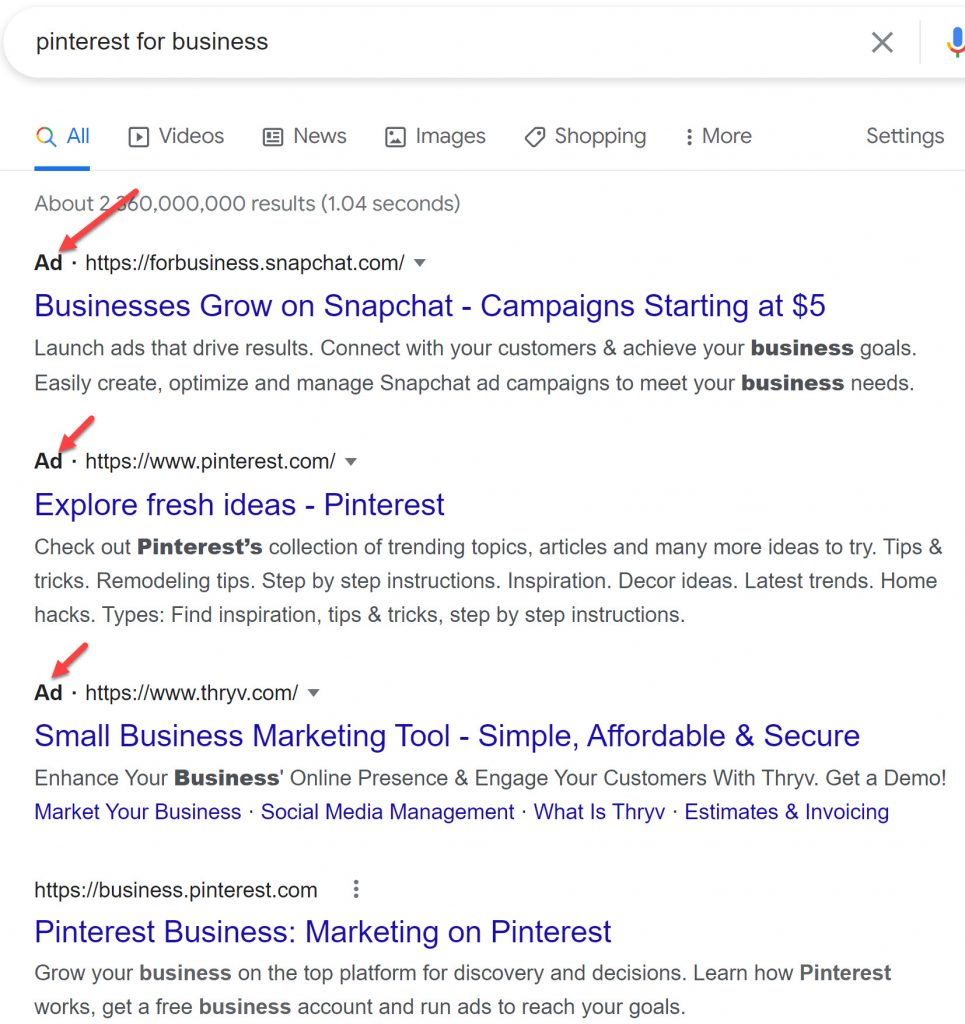
Then look at the pages that rank in the top 20 results, asking yourself:
- Is this keyword one where longer, more in-depth pillar content is ranking well (which is currently the case with the more generic search engine terms in most categories)?
- What is that page doing well?
- What are they doing that you’re not?
- What information could you add to make your page more complete?
- What ideas did you get as a result?
SEO Content Strategy Step 4: Perform A Competitive SEO Analysis
While we’re at it, let’s use our SEO tools to find out other terms our competitors are ranking for, which we may want to target ourselves.
Let’s look at one of the competitive pages to see what keywords it’s ranking for. In this case, Sprout Social’s result, currently ranking #3 in Google for the term “Pinterest For Business”:

Plugging that URL into SpyFu’s SEO Keywords tool shows that it ranks for a bunch of terms that Neil Patel’s page doesn’t:
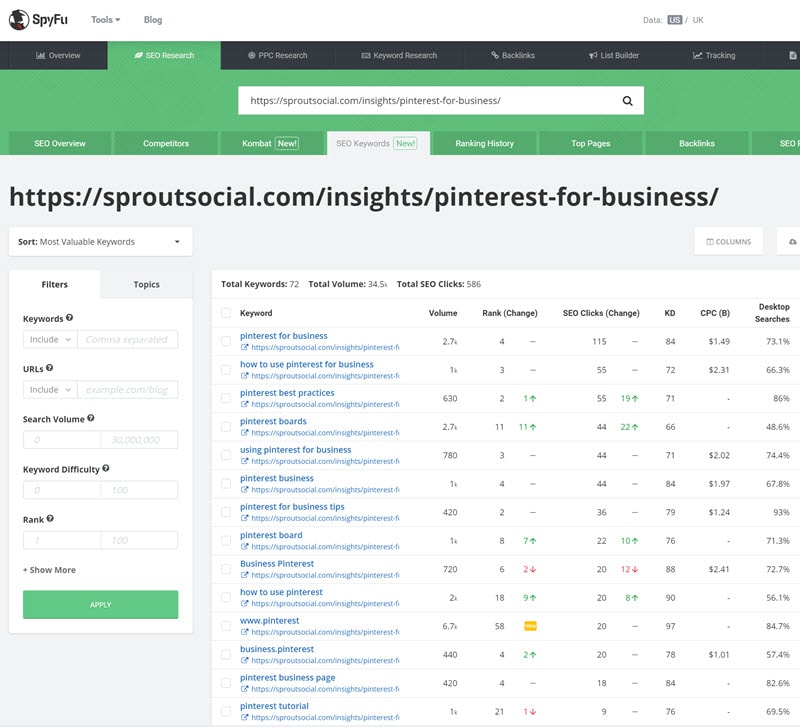
Notice the difference in keywords that each article ranks for. A lot of that difference comes from the keywords that each article writer targeted. Neil’s team likely targeted “Pinterest marketing” while Sprout’s team probably targeted “Pinterest for business.” Nothing is wrong with either term (though different terms generate more search volume and have varying levels of competition), it’s just a difference in what was specifically targeted and discussed in each article.
This type of analysis (specifically looking at what other articles rank for) reveals other opportunities you may have not thought of.
While we’re at it, let’s look at other pages that rank well to see if there are other terms both Neil and Sprout could target in their pages. Here’s an interesting page from Oberlo:
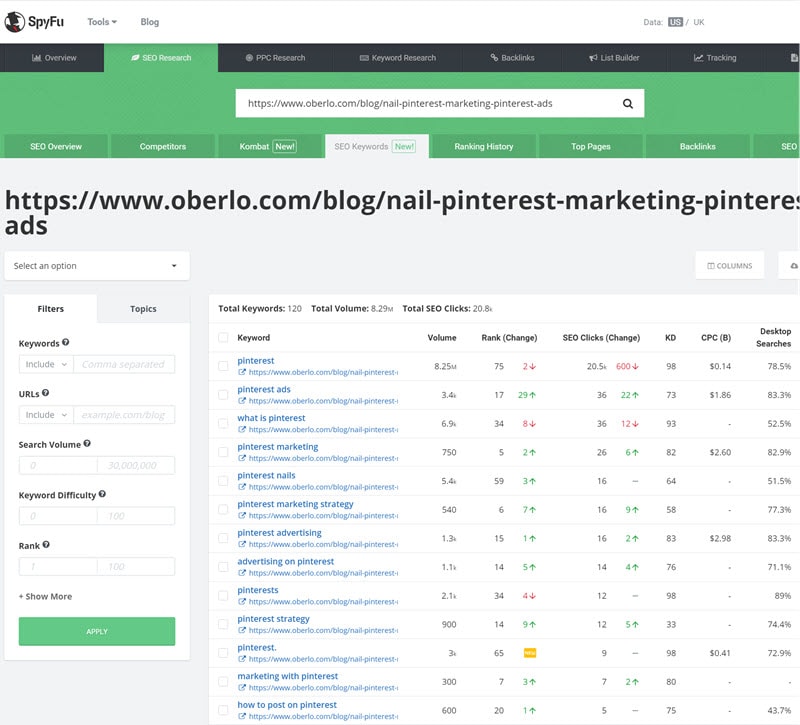
Notice how this page ranks for several advertising-related terms and how to post on pinterest that Neil’s and Sprout’s don’t.
This is part of what I mean by my statement that content can always be improved by expanding it to cover other tightly-related content. You make it better, it gets more traffic, so you do it again and the process repeats over and over again!
Neil’s, Sprout’s and Oberlo’s teams currently have an article that is already doing well, and all three could likely increase their search engine presence and traffic by adding additional content into their article that expands to touch on topics they are not currently covering.
Can you see how doing an analysis like this, then adding content to your page to focus on some of those additional keywords could significantly improve the search traffic to your site?
And, in case you’re wondering, most of the time when you do this SEO content strategy you don’t lose the rankings you already have, in fact you oftentimes improve them while ranking for new keywords you didn’t rank for before.
SEO Content Strategy Step #5: Ask Yourself The “5 Key Questions To Improve Your Content™”
Whenever I’m looking at improving content, I like to ask myself the 5 Key Questions To Improve Your Content™:
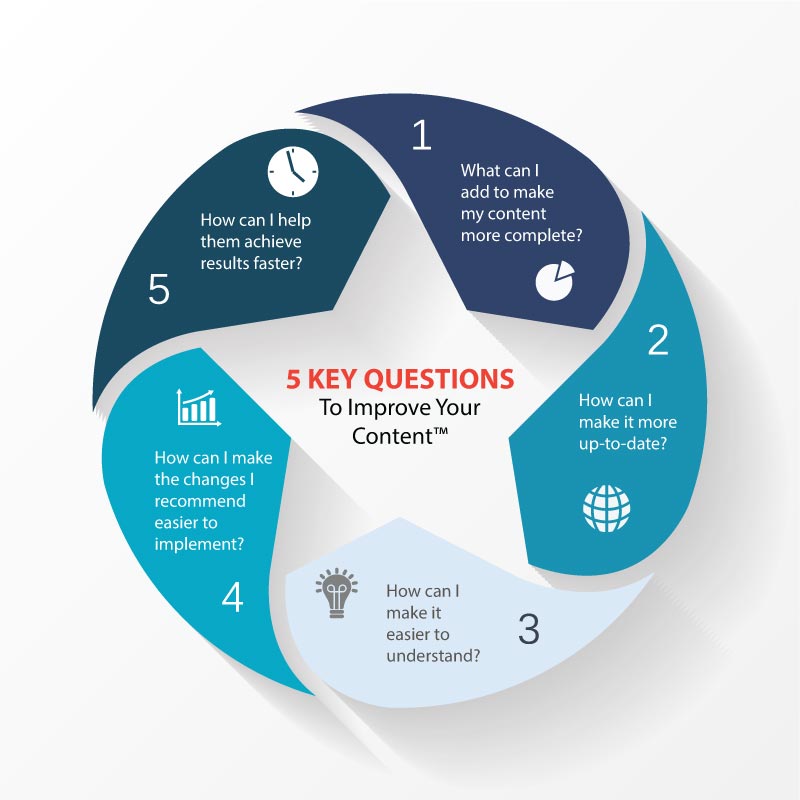
1: What Can I Add To Make My Content More Complete
Based on your judgement and what you see on the other pages that are competing with you, ask yourself the question “what could I add to make my content more complete?”
Let’s say that your article is about the best food to feed your pet aardvark. What could you do to make that more complete? Clearly, aardvarks are into ants. Where can you buy ants in bulk? What sites give the best prices on bulk orders of ants? What’s the going rate on a million ants? (Inquiring minds desperately want to know! 😊 ) By adding the answers to all of those questions you make your article more complete, better serving your audience’s needs while also enabling you to rank for those searches too.
One thing I like to do is to ask the same question in different words: “what are the key questions someone will still have after they read this article?” The answers to that question can help considerably as you work to expand the impact of your content.
But don’t stop at the basics. Part of what we’re trying to do in this SEO content strategy is to expand what our content covers so we can be relevant and excellent with other related keywords.
That would lead to asking questions like: what other foods do aardvarks also like? How do you tell if you’re feeding your aardvark properly? Enough? Not enough? What are the foods aardvarks crave that aren’t good for them (the aardvark equivalent of junk food?)
Keep pushing to other related areas. How can you tell whether your aardvark is healthy or not? What are the difference in dietary needs between a young aardvark and an aardvark in his old age, or males versus females.
I’m really stretching this metaphor. But I hope you can see my point – each set of questions you answer create more questions that you can add to your content.
Which raises an interesting question – when do you add that additional information into the existing article versus creating a new one focusing just on that topic area?
I’ll give you the definitive, highly helpful answer to that question: it depends. 😊
Part of the point of this article is that the search engines are currently favoring longer, more complete, ultimate-guide kinds of content in most categories, even more frequently for the most competitive keywords. It didn’t use to be that way, but it is now. While that may change in the future, for now, if you’ve got a top-ranking article for some long-tail keywords (or even if you have an article that’s ranking on pages 3+ in the search engine results for more popular keywords,) I’d be more inclined to add related information into that article rather than breaking it into a new one.
The question then becomes how unrelated does content has to be to pass the point of being too far from the topic of the original article. Certainly, content about what color of sweaters aardvarks prefer to wear is probably too far afield to be included in your article on the best foods to feed your pet aardvark. There’s a continuum between a list of favorite aardvark cuisines and sweater colors. You’ll have to use your judgement on that one.
By the way, mine really like purple. Sweaters, that is. 😊
2: How Can I Make It More Up-to-date?
Let’s start with data – do you have some old data in your content? Update it!
Then it helps to ask if there new discoveries, new thoughts, new ways, new suppliers, new things that you could add into your content to make it more up-to-date? This is especially true if you’re working to fix up content that was originally written several years ago or if you’re in a fast-changing environment.
And you may want to look at other time-related factors. Do you have an old video in it that wasn’t shot in high definition? Are you using graphics that look like they were created in 1998 in your garage? Are you using screenshots that show dates in the early 2000’s? This could be a good time to upgrade them all!
3: How Could I Make It Easier To Understand?
Look first at the text, is it open with non-dense copy and plenty of white space? Are you using short sentences and short paragraphs?
Do you use subheads to break it into easily-consumed sections and to enable skimming?
Do you have graphic and text elements that graphically break it up, making it less overwhelming to consume?
4: How Could I Make The Changes I Recommend Easier To Implement?
Are you giving them step-by-step instructions? Are you giving them a list of possibilities?
Look carefully at the instructions you provide. Could they be simplified? Could some steps be added or subtracted to make it easier to understand?
Does your content not include instructions? You may want to provide some.
5: How Could I Help Them Achieve Results Faster?
The last few years have brough an explosive growth of inexpensive tools that help people accomplish things they couldn’t easily do before. Examples like what Canva has added to graphics creation, Descript has added to video editing, and Unsplash has added to finding images to use in your content.
You may want to consider recommending some of those in your content, enabling your visitors to achieve the results they desire faster than they could before.
These Questions Make Your Content Deeper And Wider
As you ask yourself these types of questions, your content becomes a little less highly siloed around one specific topic, which is an important aspect of improving your SEO content strategy.
In other words, you’re slightly un-niching your content to expand it’s reach into other search terms.
Remember, you already were performing well enough to rank for a certain set of terms, what you’re doing now is drilling deeper and slightly wider, both to improve your ranking for the terms you already rank for and to expand into new terms so your content can rank for them too.
As a result, your page becomes even more valuable than it was before.
And the search engines start sending traffic to it for more terms than they were before.
All of a sudden that page that was getting you a thousand visitors a month now is getting you 1200, then 1500, then someday hopefully 2,003,000 visitors. I frequently see this strategy take pages from a thousand visitors to 10,000 a month, simply by upgrading them and answering additional questions that people have.
SEO Content Strategy Step 6: Add Other Elements To Improve Your Coverage Of Your Topic And Make It Easier To Consume
Elements like:
Video
Video is such a powerful communications tool that it should always be considered as a way to augment your page, to improve your communications, and to enable those who prefer watching to reading to consume your information.
And when you do it by embedding a video from your YouTube channel, you double your results: your post gets better results and the video views from that post contribute to your YouTube view count and rankings.
Plus, that video on YouTube can bring traffic back to your blog page. Simply link to it in the description and put in a card linking to that page in your video.
But why stop at just one video?
When you start developing quality longer-form content, that content will oftentimes cover too much to address sufficiently in just one short video.
News Flash: you can have more than one video in an article!
Let’s say you wrote an article, including a video, about strategic planning.
Later you improved that article and included a section helping them identify their target audience. Great – add another video on identifying your target market into that post.
Add some more content about recommended marketing strategies? Bam, there’s another video.
Pretty soon your article could contain five or more videos, each of them an incredibly valuable piece of content on its own, each talking about a specific concept which all combine to turn your simple article into one of the best in the world on that particular subject.
I invite you to scroll up and look at the 5 Key Questions To Improve Your Content™ and recognize that you can answer each of those questions not just with text, but also with a video!
By asking what are the logical questions that someone still has when they get done perusing this content, and then creating a video to answering that content in that piece, plus addressing it in the body text, you’re significantly improving the quality of your content.
Graphic Elements
Lots of people think about adding pictures, which is fine, but a much more powerful element is to think in terms of instructional graphics.
Instructional graphics include things like flowcharts, infographics, screenshots, and step-by-step instructions. I’ve included a couple of instructional graphics in this article.
And remember, those graphics don’t have to be plain old still graphics. There are tools now that make it easy to add motion animations to your graphics, further increasing their power and attraction potential.
And, of course, pictures add to the readability, interest, and clarity of text.
Links
If you’re one of those people who believes that you should never add links to your pages, your information is out-of-date.
Certainly, links within your own site are an important part of increasing the value of your pages.
But there’s nothing wrong with adding links to other peoples’ sites too. Remember, what you’re trying to do is to add value to your content. Links can provide that.
Add related content
When you’ve got great content on a particular subject, people naturally trust you and want to know more when they’re finished consuming it. Adding related content, especially tightly-related content can help to continue informing them about this subject.
SEO Content Strategy Step 7: Combine Related Content Into One Amazing Page
Most people never think of this step, but it’s a simple addition to your SEO content strategy and a powerful way to achieve amazing increases in traffic.
Let’s imagine that over the months/years you’ve developed a series of pages that are very close in subject but focus on slightly different areas of that subject. Each one of those pages is probably bringing in some traffic on its own.
I invite you to consider
- Combining those pages into one giant page that covers, in depth, multiple aspects of that subject.
- Redirecting the old URLs to this new one.
It won’t happen immediately, but generally after a couple of months, you’ll likely find that the combined page now is not only ranking for all the terms that each of the individual pages used to rank for, but it is now an even better page overall, doing a much better job of addressing the pain the searcher was looking to solve.
Now it’s starting to get ranked for the whale terms – those major category-generic terms that get several magnitudes more searches than the long-tail terms those separate pages used to rank for.
This enables you to achieve rankings you’ve literally been able to achieve before, even to go from 10,000 visitors a month to 100,000.
Think about it… it’s somewhat risky, but if you do it correctly, it can be incredibly powerful!
Some Final Thoughts About Increasing The Value Of Your Content To Get More Traffic and Improve Your SEO Content Strategy
- The main place you should focus is to improve your best performing content.
You should know that you can often 10X your traffic or more just by spending a few hours, or maybe a day’s worth of work on upgrading that content to the next level, with next level defined as helping your visitor better achieve the transformation they’re seeking. - As you do this process, make sure you’re actually improving your user’s experience not just making your content longer. That’s what the search engines are looking for – they want to give the very best user experience.
- Be aware of all aspects of that user experience. If the result of all your changes is that it now takes ten seconds for your page to load, because you’ve got so many graphics on it, you just shot yourself in the foot.
- This is worth doing now rather than later because it can significantly change the way you show up, the impact you and your content have on the world, the traffic you’ll get, and the business that will result.
- Remember, you’ll do this in stages. Maybe this week you’ll focus on your #1 page, next week the next, etc. You don’t have to stress yourself out over this process. Just do what you can, always improving your content, and your results will always be improving!
Perhaps this element of your SEO content strategy should become part of your weekly plan. Each week, you choose another article, make it better, and just keep going down the list. Then see what ends up happening.
This stuff works. I’ve done it over and over and over again throughout my career, both from my own sites, as well as the sites of others that I’ve worked with.
I strongly suggest you do this too.
This is Don Crowther saying just go do this stuff.


